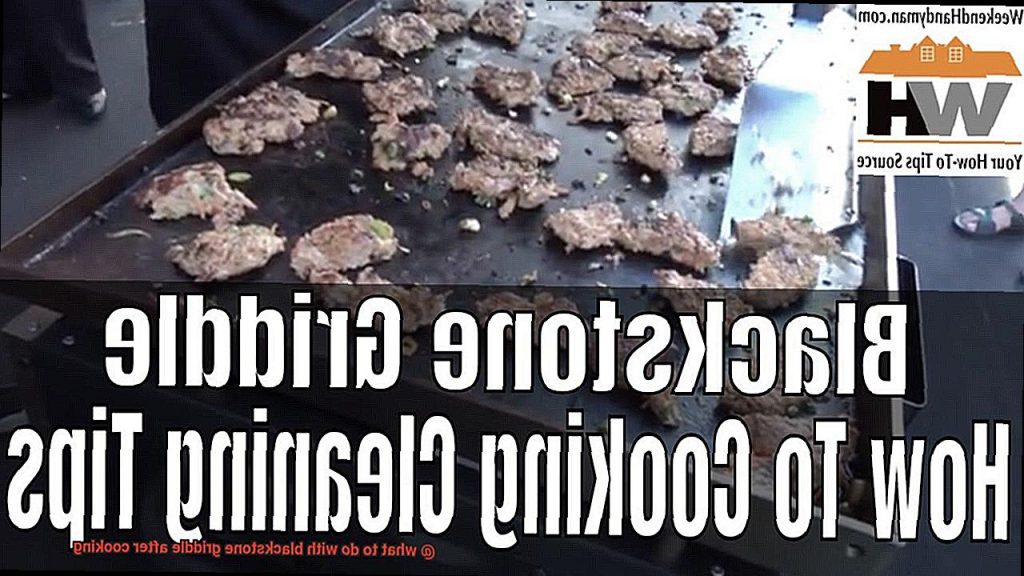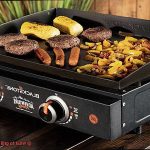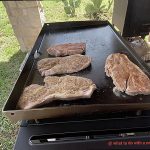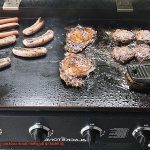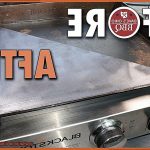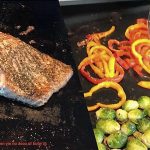Are you a grill-master or an outdoor cooking enthusiast who loves to whip up mouth-watering meals on your trusty blackstone griddle? If so, then you know that this versatile appliance is perfect for cooking up everything from hearty breakfasts to juicy burgers and sizzling vegetables. But once the cooking is over, what’s next?
Some folks might be tempted to move on to the next task without giving their griddle a second thought. However, taking proper care of your blackstone griddle is essential for maintaining its longevity and performance. Not only will it help ensure that your dishes taste their best, but it can also prevent cross-contamination of flavors.
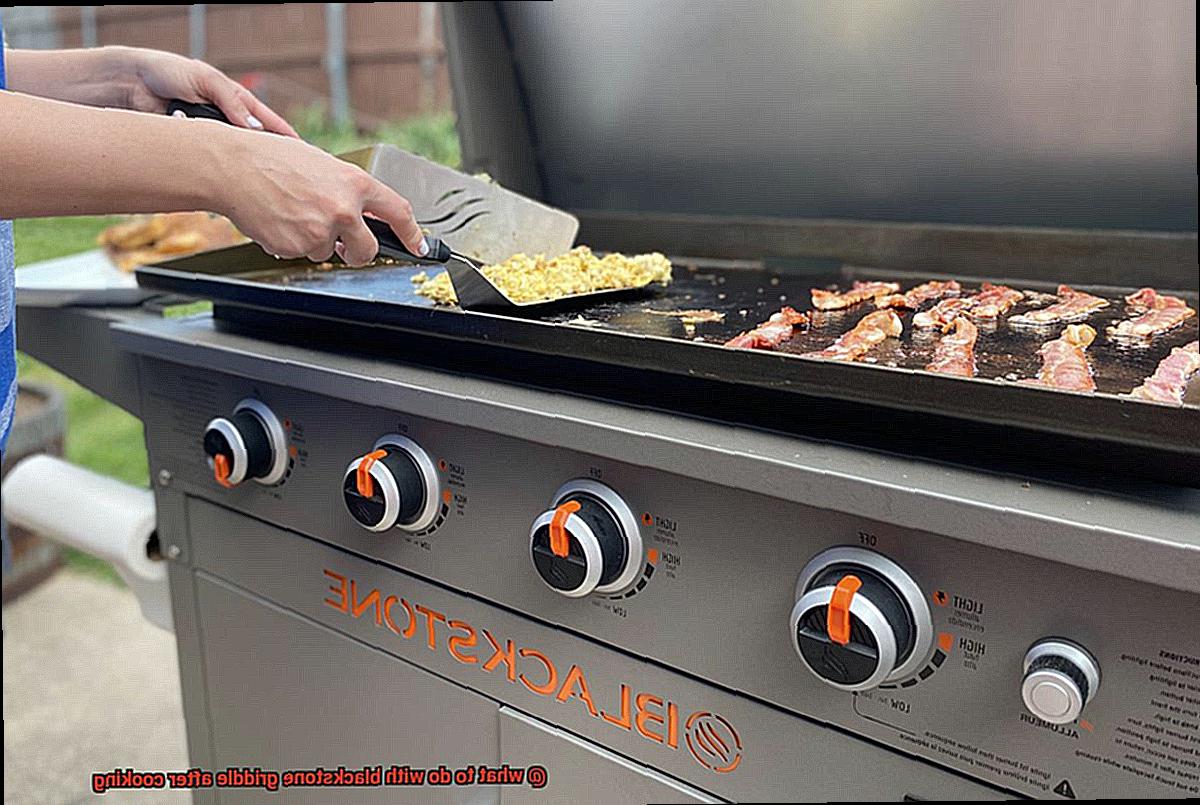
In this blog post, we’ll share our top tips for what to do with your blackstone griddle after cooking. From simple cleaning strategies to seasoning tips and storage recommendations, we’ve got you covered. So if you’re ready to learn how to keep your blackstone griddle in tip-top shape like a pro, read on.
Contents
Turning off the Heat and Letting the Griddle Cool Down
Cooking on a Blackstone griddle can be a thrilling experience. However, it’s essential to properly clean and maintain it after each use to ensure it lasts for years to come. One crucial step in this process is turning off the heat and letting the griddle cool down before cleaning it.
Why is this step so crucial? Let’s delve into the reasons.
Firstly, turning off the heat and letting the griddle cool down can prevent burns and injuries. Accidentally touching a hot surface can cause severe burns, which is why allowing the griddle to cool down naturally is crucial. It may take some time, but it’s worth it to avoid any potential accidents.
Secondly, cooling down the griddle helps protect the cooking surface from warping or cracking. Using water to cool down the griddle is a big no-no, as it causes warping or cracking of the cooking surface. Instead, allow the griddle to cool down naturally by leaving it uncovered and in a well-ventilated area.
Thirdly, once the griddle has cooled down completely, it’s ready for cleaning. This is the time to remove any excess food debris or grease with a scraper or spatula. After cleaning, wipe down the surface of the griddle with a small amount of oil to help prevent rust and keep the griddle seasoned for future use.
Fourthly, using an oil with a high smoke point such as vegetable or canola oil is recommended. By doing so, you will help maintain the seasoning on your griddle surface. This will allow you to cook delicious meals on your griddle every time.
Finally, following these steps after cooking on your Blackstone griddle ensures that it remains in excellent condition and performs at its best for years to come. It’s also important to periodically check and tighten any screws or bolts to ensure that the griddle remains stable and safe to use.
Removing Excess Food Debris and Grease
It not only ensures the cleanliness of your griddle but also helps maintain its longevity and performance.
To start, use a scraper or spatula to remove any large pieces of food that may have been left behind. Doing this while the griddle is still warm makes it much easier to remove any stuck-on debris. Once the larger pieces are removed, use a paper towel or cloth to wipe away any remaining debris. This will leave you with a clean and fresh surface for your next cookout.
Next up, let’s talk about excess grease removal. This is where the provided grease cup or container comes in handy. Simply slide the cup underneath the grease drain and dispose of the grease in a safe manner. Alternatively, you can use a plastic scraper tool to gather any excess grease and dispose of it in a container or trash bag. It’s important to remember to never pour excess grease down the drain as it can cause plumbing issues that you definitely don’t want to deal with.
In summary, here are the steps you should take to remove excess food debris and grease from your Blackstone griddle:
- Use a scraper or spatula to remove large pieces of food while the griddle is still warm.
- Wipe away any remaining debris with a paper towel or cloth.
- Use the provided grease cup or container to safely dispose of excess grease.
- Alternatively, use a plastic scraper tool to gather excess grease and dispose of it properly.
Wiping Down the Surface with Oil
Look no further than the simple yet vital step of wiping down the surface with oil.
You may be wondering, “Oil? On my griddle? Won’t that make it greasy?” But fear not, dear readers. This process is actually critical to maintaining your griddle’s longevity and optimal performance.
First, after cooking, scrape off any excess food debris and grease using a scraper or spatula. Then, once the griddle has cooled down slightly, it’s time to apply the oil.
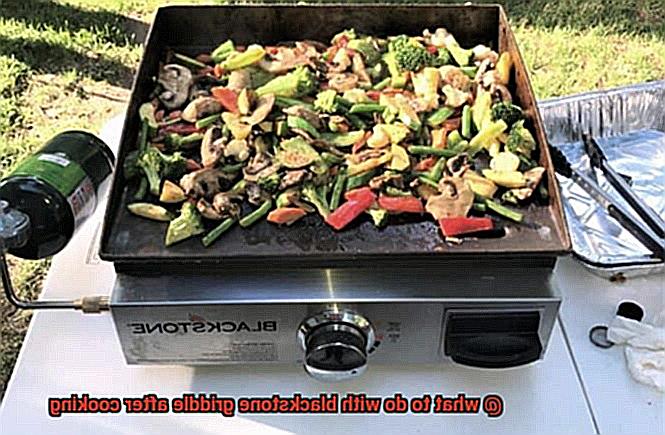
Using a clean cloth or paper towel, apply a small amount of high-heat oil, such as vegetable oil or canola oil, onto the surface of the griddle. Be sure to spread it evenly across the entire surface, including any corners or crevices.
Next, turn up the heat on your griddle to allow the oil to cook into the surface. This will create a protective layer that prevents food from sticking and helps keep your griddle clean. After a few minutes, turn off the heat and allow the griddle to cool down completely before wiping away any excess oil with a clean cloth.
Not only does this process help season the griddle, but it also prevents rust and corrosion while creating a non-stick surface for future cooking. By following these steps after each use, you’ll ensure that your Blackstone griddle remains in excellent condition for years to come.
Removing Stubborn Burnt-On Particles and Grease
Cooking on a Blackstone griddle is a delightful experience, but cleaning it afterwards can prove challenging, especially when stubborn burnt-on particles and grease refuse to budge. As an expert in all things griddles, I have compiled some tips to help you remove those pesky particles and grease from your Blackstone griddle.
First things first, safety should always be top priority. Ensure that the griddle is turned off and has completely cooled down before attempting to clean it. Using a scraper or spatula, remove any large food particles or excess grease that can easily be scraped off.
For those tenacious burnt-on particles and grease that won’t yield, try using warm water and dish soap. This mixture works wonders in removing stubborn grime. Apply the soapy solution to the affected areas, let it sit for a few minutes to loosen up the dirt, then use a griddle stone or scrubbing pad to gently scrub away the remaining residue.
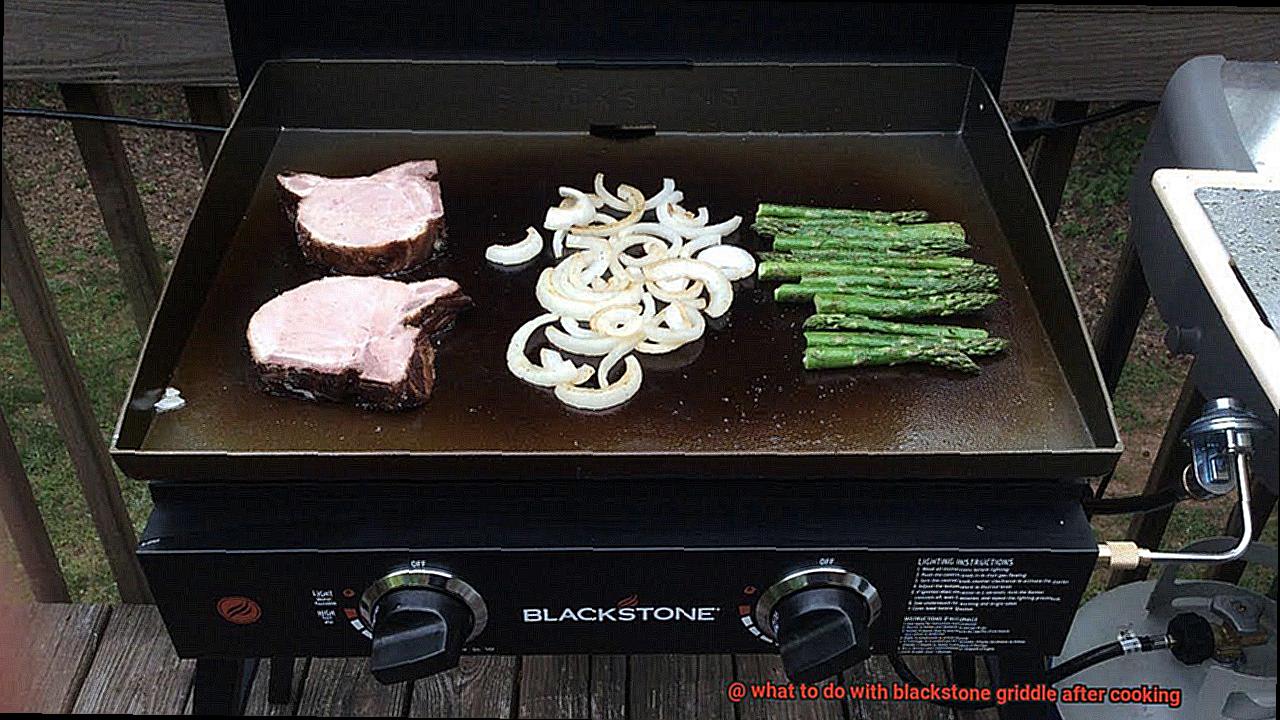
If dish soap doesn’t work, you can also try using commercial-grade degreasers specifically designed for griddles. Follow the instructions on the product label carefully and wear gloves and protective eyewear. These degreasers are formulated to break down tough grease and grime quickly and effectively.
Once you have successfully removed all the burnt-on particles and grease, rinse the griddle thoroughly with hot water and wipe it down with a clean towel. You can also use a food-safe sanitizer to further sanitize the surface.
To summarize, here are some key takeaways:
- Safety comes first: ensure that the griddle is turned off and cooled down before cleaning.
- Remove large food particles or excess grease with a scraper or spatula.
- Use warm water and dish soap for stubborn burnt-on particles and grease.
- Commercial-grade degreasers specifically designed for griddles are another option.
- Rinse thoroughly with hot water and wipe down with a clean towel.
- Use a food-safe sanitizer for added sanitation.
Scrubbing the Surface of the Griddle
If so, you know that proper maintenance is key to keeping your Blackstone griddle performing its best. One essential step in the cleaning process is scrubbing the surface of the griddle. But fear not, we’ve got you covered with some expert tips and tricks.
First things first, safety is paramount. Allow your griddle to cool down completely before starting the cleaning process. And for extra protection, consider wearing gloves.
Once cooled, grab a scraper or spatula and remove any leftover food debris or grease from the surface of the griddle. But be sure to scrape in a single direction to avoid damaging the surface.
Next, use a damp cloth or sponge to wipe down the surface of the griddle. If you encounter stubborn stains or residue, don’t worry – a mild detergent can help. But whatever you do, avoid using abrasive cleaners or steel wool as these can scratch the griddle’s surface.
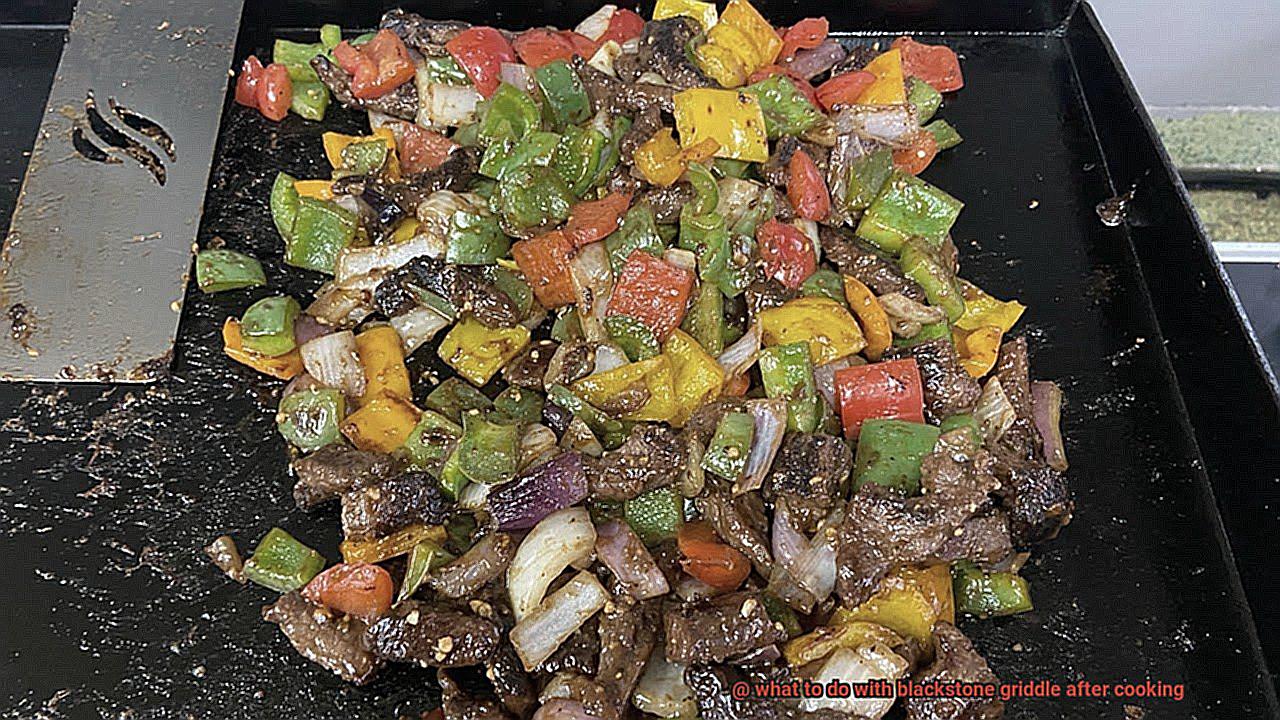
For tougher stains or buildup, try mixing water and vinegar or baking soda to create a paste. Apply the paste to the affected areas and let it sit for several minutes before scrubbing with a non-abrasive pad or brush.
Once you’re happy with your scrubbing efforts, rinse the griddle thoroughly with water and dry it with a clean towel. And here’s a pro tip – some experts recommend seasoning the surface of the griddle with oil after cleaning to help maintain its non-stick properties.
To sum it up, here are some key takeaways for successful griddle scrubbing:
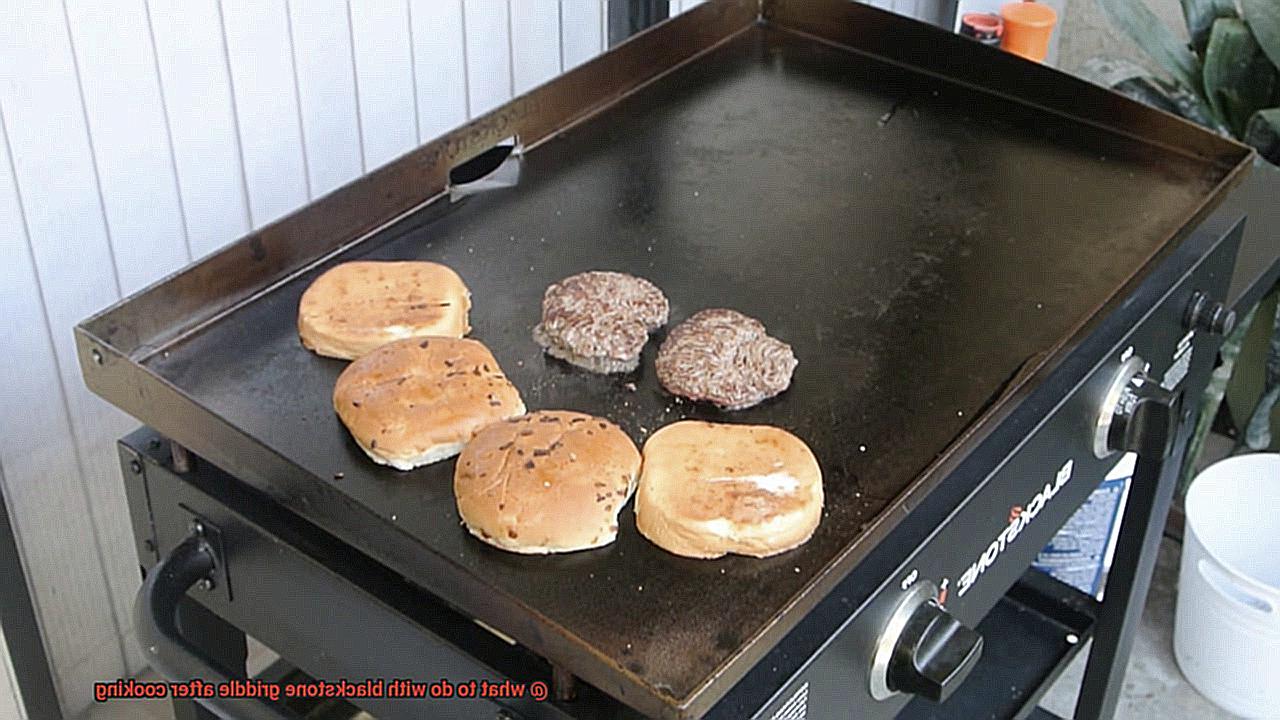
- Let your griddle cool down completely before cleaning
- Use a scraper or spatula to remove food debris and grease
- Wipe down the surface with a damp cloth or sponge
- Avoid using abrasive cleaners or steel wool
- For tougher stains, use water and vinegar or baking soda to create a paste
- Rinse thoroughly and dry with a clean towel
- Consider seasoning the surface with oil after cleaning
Storing the Griddle in a Dry Place
Cooking on a Blackstone griddle is a delightful experience, but it’s equally important to take care of the griddle after use. Proper storage of the griddle is crucial to ensure its longevity and performance. In this guide, we’ll explain the importance of storing your Blackstone griddle in a dry and secure place, along with some tips to make sure that you can do so with ease.
Firstly, moisture is the enemy of a griddle. Storing it in a humid or damp place can lead to rust and corrosion formation on the surface. This not only affects the cooking surface but also ruins the flavor of your food. Hence, it’s essential to store your griddle in a dry and well-ventilated area, such as a garage or shed. This will prevent any moisture from accumulating on the surface.
Another aspect to consider when storing your Blackstone griddle is protecting it from dust and debris. It’s frustrating to clean a dusty griddle before cooking, so covering it with a protective cover or cloth is essential. This will prevent dirt or dust from settling on the cooking surface and protect the griddle from any scratches or damage that may occur during storage.
Lastly, ensure that your Blackstone griddle is stored in a stable and secure position. Unstable placement may lead to accidents or damage that could ruin your beloved griddle. Therefore, make sure that the legs are securely locked into place, and the griddle is placed on a flat surface. This will prevent any accidents from occurring during storage.
Covering the Griddle to Protect it from Dust and Debris
And the key to achieving this is by investing in a high-quality cover for your beloved griddle. But why is covering the griddle so important? The answer is simple – dust and debris are the enemies of any cooking surface. Not only do they make the griddle unhygienic, but they can also affect its performance, making it harder to cook your favorite meals.
Fortunately, a good cover comes in handy to protect your griddle from all sorts of environmental factors like rain, wind, and dust. By keeping your griddle covered, you are ensuring that it stays clean and ready for your next culinary masterpiece.
When choosing a cover for your Blackstone Griddle, go for one made of high-quality material that can withstand outdoor conditions. Opt for a waterproof cover that is UV resistant and made from durable materials. Also, ensure that it fits snugly over the griddle to prevent any debris from entering.
It’s crucial to keep the surface of the griddle clean and dry before placing the cover over it. Wipe off any excess oil or food particles with a damp cloth and let it dry for a few minutes. Once the surface is dry, place the cover over the griddle and secure it with any straps or fasteners provided.
Remember to remove the cover before using the griddle again. Leaving the cover on while cooking can cause condensation to build up, leading to rusting and other damages. Additionally, the cover may melt if left on while cooking at high temperatures.
Periodically Checking and Tightening Screws or Bolts
If so, ensuring that your griddle is always in top working condition is crucial. One essential aspect of maintaining your griddle is periodically checking and tightening screws or bolts. Let’s explore why this is so important and how you can ensure the safety and longevity of your trusty cooking companion.
Over time, the vibrations and heat generated by the griddle can cause screws and bolts to loosen up, which can compromise the stability of the griddle and pose a risk of damage or injury. To prevent this, it’s vital to regularly inspect all the screws and bolts that hold the griddle together, including those that secure the legs, burners, and any other components of the griddle.
So, how do you go about checking and tightening these screws or bolts? Start by turning off the griddle and allowing it to cool down completely before attempting any maintenance work. Then, using a wrench or screwdriver, gently tighten all visible screws and bolts. Don’t forget to replace any that are loose or missing promptly.
To ensure optimal safety, it’s also crucial to pay attention to any strange sounds or movements coming from the griddle while in use. If anything seems unusual, stop using the griddle immediately and inspect all components thoroughly for any loose or damaged screws or bolts.
czITdvHgTSg” >
Conclusion
In conclusion, your Blackstone griddle is more than just a cooking tool – it’s an investment that requires proper care and maintenance. After whipping up a delicious meal, it’s crucial to let the griddle cool down before cleaning it to avoid any potential injuries or damage.
To keep your griddle in top-notch condition, removing excess food debris and grease with a scraper or spatula is essential. Not only does this ensure cleanliness, but it also prevents cross-contamination of flavors and maintains longevity.
Once you’ve cleaned the surface, don’t forget to season it by wiping it down with oil. This step not only helps prevent rust and corrosion but also creates a non-stick surface for future cooking.
For those stubborn burnt-on particles and grease, scrubbing the surface with a damp cloth or sponge using mild detergent or water and vinegar/baking soda paste can work wonders without damaging the griddle’s surface.
When it comes to storing your Blackstone griddle, make sure to keep it in a dry place like a garage or shed covered with a protective cover/cloth. This will prevent rust formation on the surface and protect it from dust/debris that may cause scratches/damage. And finally, periodically checking/tightening screws or bolts that hold the griddle together ensures optimal safety during use.
By following these simple yet effective tips for what to do with your Blackstone griddle after cooking, you’ll be able to enjoy delicious meals on its non-stick surface for years to come.

